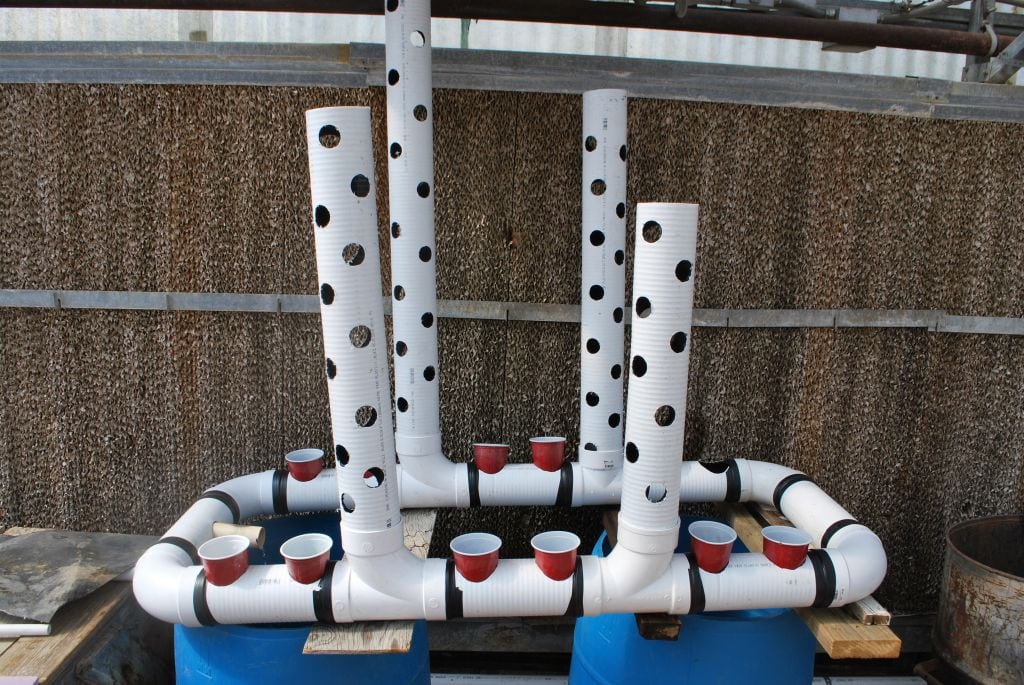
Photo: Sean Brady
Turn a small yard, a corner in a community garden or an unused space in your home into a thriving vertical farm for vegetables and fish. A household-sized vertical aquaponic system can fit into a 3ft by 5ft (1m x 2m) area and feed a family year-round. Sean Brady worked as the aquaponics projects coordinator at the Center for Sustainable Aquaponics and Nourish the Planet in Loveland, Colorado, when he showed us how to build a system from scrap he found around the greenhouse.
More food, less water
A vertical aquaponic system grows vegetables without soil in columns above a fish tank. It is a water-efficient and space-saving way to garden and raise fish. By growing vertically, you can produce about twice the amount of plants as you can with a hydroponic system of the same area. One five-foot tower can produce more than 200 heads of lettuce per year. And it uses a small fraction of the water needed to grow crops in soil.
Mutual benefits
The aquaponic system puts fish waste to work as fertilizer for crops. A small pump draws nutrient-rich water from the fish tank to the tops of the vertical columns. The water trickles down through the roots of the plants, gathering oxygen from the air as it falls back into the tank. The system is mostly enclosed, with little to no waste and no need for fertilizer or pesticides. And, if you do it well, you won’t have to clean the fish tank much.
You would have to replace lost water as needed, power the pump and feed the fish. It might not be too hard to power one of these pumps with a small solar panel or some other renewable energy. If anyone has an idea, please share.
This is how to build Sean Brady’s low-cost vertical aquaponic system. All the photos are his, and if you have questions for him, you can contact Sean Brady on LinkedIn or email him at bradyaquaponics@gmail.com.
Materials
You can use the following materials or swap out anything for whatever you have on hand. Brady built this system from scrap he had around the greenhouse. We’re including pictures of other, fancier systems that he built out of similar materials to show the diversity that this kind of build affords. Measurements are in feet and inches. Sorry, rest of the world.
- Pipes
- 15-20 ft. of 4-in. diameter PVC or ADS
- Four 4-inch elbows
- Four 4-inch T connectors
- Two 50-gallon drums
- 15-20 ft. of pex tubing, or aquarium tubing
- Plastic cups
- Strips of cloth, such as burlap sack, cable ties or another fastener
- Scrap wood
- Two rolls of electrical tape
- Pumps
- One water pump – the size depends on how much flow it would need. An aquarium pump is enough to keep the flow going.
- One air pump (optional). The system can aerate itself but it can produce more if it has an air pump.
Tools
- Power drill or hand drill
- 1-in hole saw
- 3-in hole saw
Build time
About two hours.
Recommended plants and fish
Leafy vegetables, tomatoes and herbs do well in these systems. So do flowers. You can experiment to find which do well and fit your needs.
Tilapia and trout do well, they grow quickly and they’re delicious.
Step One: Prepare the base pipes

Photos: Sean Brady
Cut the pipe into six 1ft. sections for the sides and two 14in. sections for the ends.
Drill two 3in-diameter holes in each of the 1ft side pieces.
Drill a 1in-diameter hole into the side of one of the end pieces.
Then assemble the pieces with electrical tape.
Tip: You can use any kind of durable plastic or pipe, not just what’s pictured.
Step Two: Place the vertical pipes
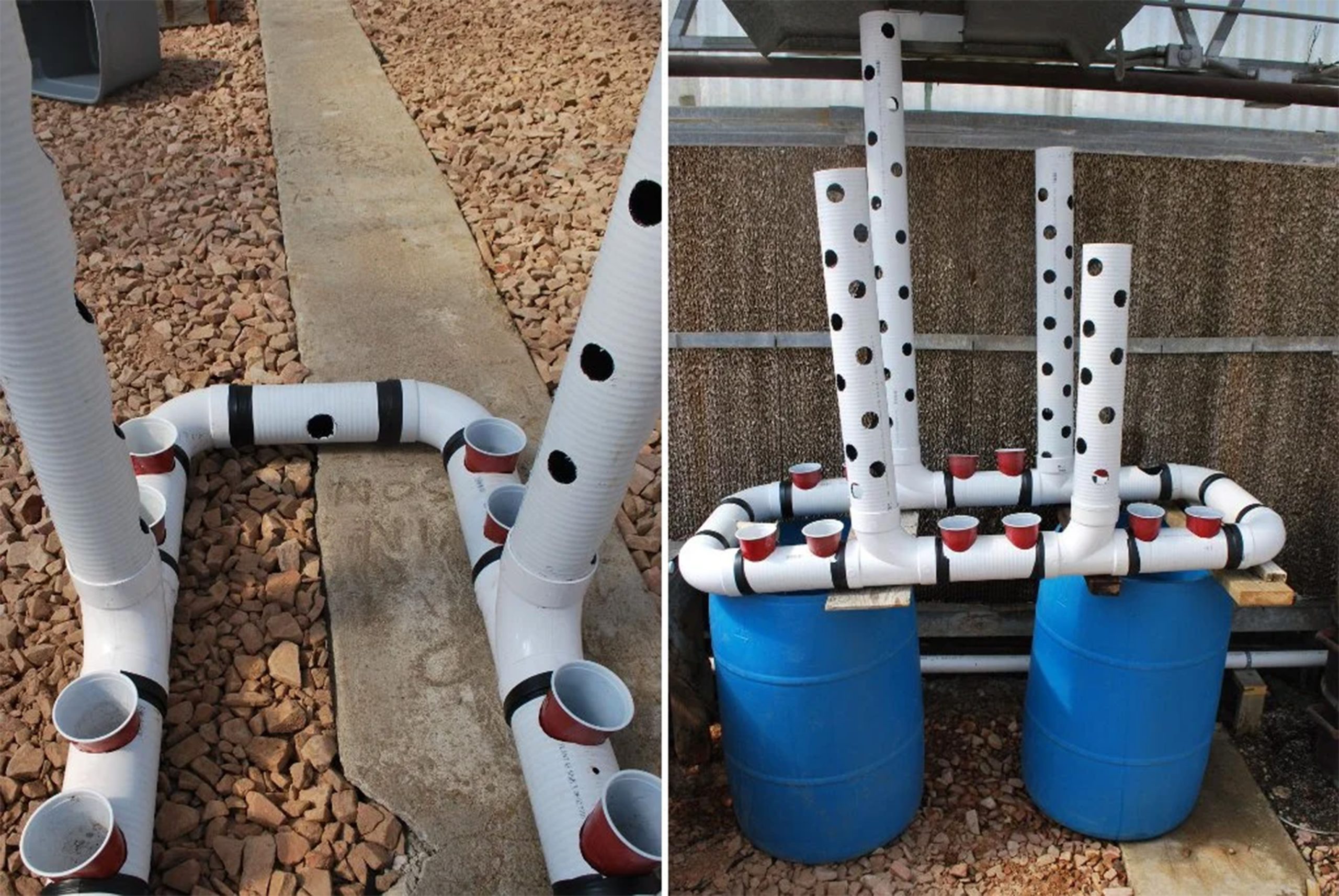
Photos: Sean Brady
Cut the vertical pipes to the length that suits you.
Drill 1in-diameter holes in the vertical pipes, evenly spaced.
Insert the vertical pipes as shown.
The photo on the right shows the mostly finished structure to give you an idea of how it looks.
Step Three: Place the cups, make a drain
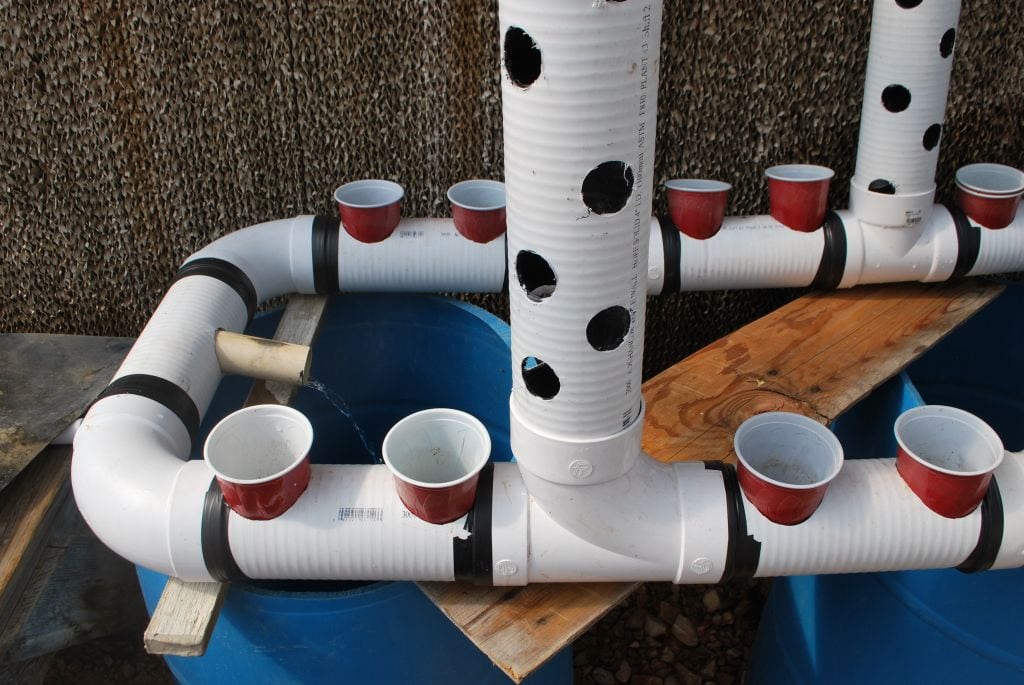
Photo: Sean Brady
Perforate the bottoms of the plastic cups and place them in the holes you drilled in the side pipes.
Cut a piece of 1in-diameter pipe to insert into the 1in hole in the end pipe to make a drain.
The drain should pour into one of the 50-gallon drums.
Step Four: Make a fish tank

Photos: Sean Brady
You can use two 50-gallon drums like these or any other kind of container that holds water for fish. You could even scale this down and put it on top of an indoor aquarium.
Cut the tops off below the rims.
Step Five: Put it all together

Photos: Sean Brady
This is the assembled garden structure on top of the drums, seen from two slightly different angles.
Adjust the structure’s balance and support its joints with wooden boards. You could tilt the structure slightly toward the drainpipe to improve the water flow.
Most systems will have vertical columns of equal height, but these are cut at different heights to show the range of options available.
Seed the plants in these. Put them in the cups and the holes in the vertical columns.
The final steps are not pictured, but easily explained. Cut strips of burlap or some other material, fasten them to the tops of the vertical pipes and drape them down the inside of the pipes. Stuffing the pipes with cloth like this will give the plant roots something to latch on.
Next, cut and assemble the tubing so that you can pump water from one barrel up to each of the four vertical pipes. You could also pump water from the barrel that receives drainage to the barrel that feeds the system.
Scaling up to bigger, fancier systems

Photos: Sean Brady
These systems can scale up to commercial size, too. Mr. Brady and his colleagues at the Center for Sustainable Aquaponics set up this greenhouse for leafy vegetables, herbs and fish.
Tap your creativity

Photos: Sean Brady
This arrangement portrays some of the creativity and even the beauty possible with an aquaponic system. Among its features, there is a rocky waterfall into the fish tank and a drip-irrigation system watering soil-free plants in a rock bed.
Here’s the harvest
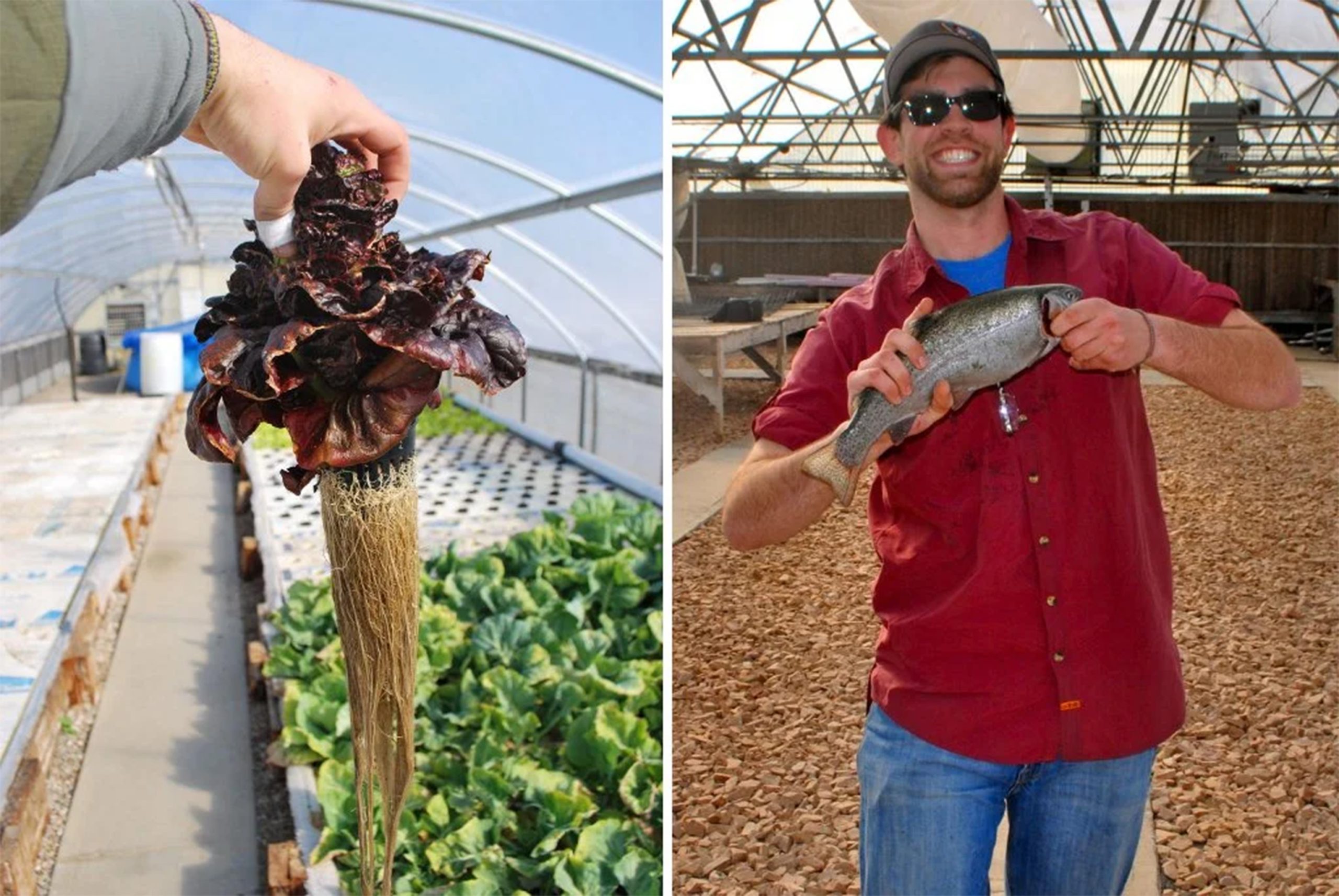
Photos: Sean Brady
Our guide Sean Brady shows what these systems can produce. He’s holding a trout here.
Time to make your own
And tell us about it! Email us or post a link in the comments to show us what you’ve done.
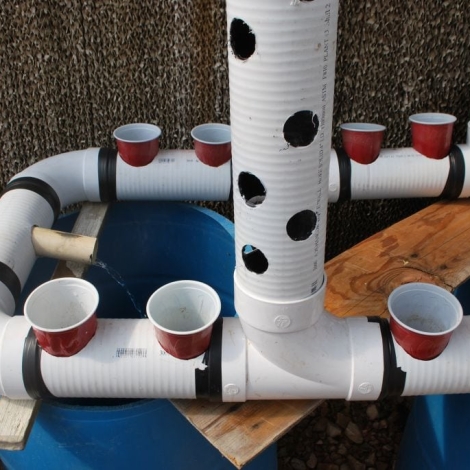

Is this hard to build?
Is there a formula to calculate how many fishes is enough for how many plant?
this is spectacular. A more in depth article would be greatly appreciated. The follow up could include Equations, fish to plants ratios, aspects of thermodynamics. I thought fish tanks, and gardens required a great deal of attention. Combing both is totally rad, and the results are extraordinary. It’s like having a goose that lays golden eggs!
Very exciting!
How to build a horizontal aquaponic system
its quite interesting . can we implement it with iot devices ? like.. fully automation ?
I have know your site quite somo time, i like the idea, i think that i would want to build something alike, i think the improvement I would try to make is to make the sistem more modular and with less space around it, or perhaps more height, thanks for sharing
I just dont understand exactly how the water is fed into the system
Vertical
21 Kani Zand St. Bintika Qr.
General Directorate of Agriculture/ Animal Production
Could you send me an offer for capacity of 100 tons fish meat annually please ?
awesome….
Why have 2 drums, can’t you pump water out from the same drum that is having fishes?
Can I Use a vertical aquaponics system to grow a new harambe?
i do not understand the process of flowing of water,please help me.
i see many people are struggling with the concept of ratio… the way you figure that out is by figuring out the size of your fish tank. your fish tank will depict how many fish you can raise and that size would be able to tell you the amount of fish you can raise in that space. then it’s abut 3-1 ratio of space.
so say your tank is 1m cubed
that would mean you could have 3m squared (growing beds are 30cm deep) of flower bed space.
i am new to this but this is as far as i understand it.
187 E. Camino De Diana
Good idea. well demonstrated. thanks.
Hey hai am Santhosh.S , am very much intresred in Aquaponics and am from India . I want to use this method in Native place , So suggest me some of your technics as much as possible.
It’s supper please help me how to get training in aquaponic and supplies of tools required. Am in Tanzania 0755178790
I am living in Jordan were we have a lot of sun and lack of water. I would like to install an aquaponics system in my balcony. To grow my organics vegetables to avoid buying the commercial harmful vegetables in the local market.
The majority of people here live in apartments with no access to normal lands. Can you please help me with aquaponics system design in my outside balcony. I can provide you with the actual space sizes and some photos.
Thanks for your support in advance.
Hanna
I liked it very much though the final pictures could have a very powerful message.
I am searching of how to keep the fish, vegetations and flowers indoors/outdoors.
Thanks
Please forward the manufacture and model/part number of the white 4-in. diameter PVC. I have looked for PVC that is ribbed and cannot find supplier. Thanks.
I do not understand where the biofilter is in this design.
There is no river rock just the burlock.
Please can you clarify. Other than that it seems a great idea
HI great concept..may i ask what kind of material you use at picture 9..where you seed the plants in this material and put in the holes, i dont even understand how burlaps will be installed, will it be inserted troughout the whole lenght of pipe or just at the holes?
the last picture that the man holding fish is that fish is Salmon??
yes we are. im in developing phase right now but its for hydroponic system. with little basic automation like auto watering, temperature and humidity monitoring and for the improvement, pH and nutrient meter will add later even its costly enough
Nice Concept